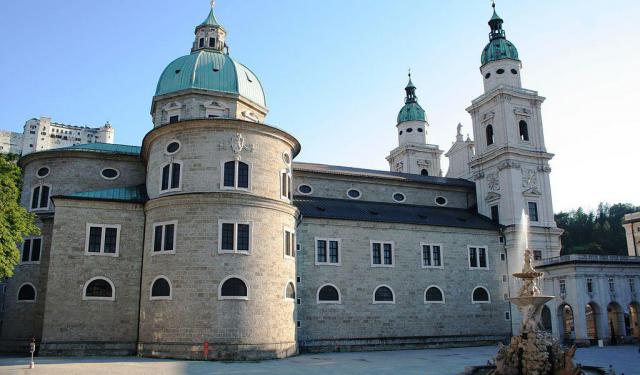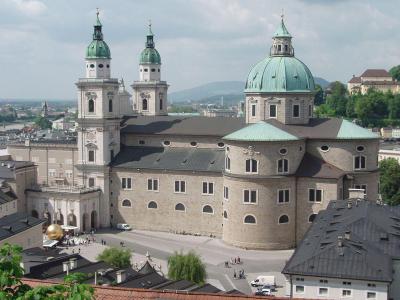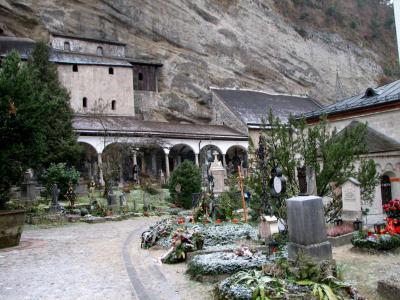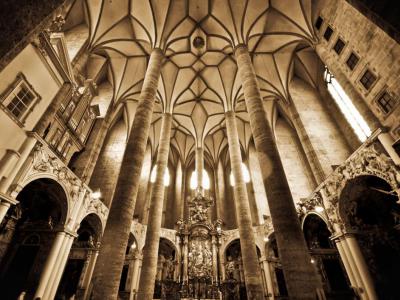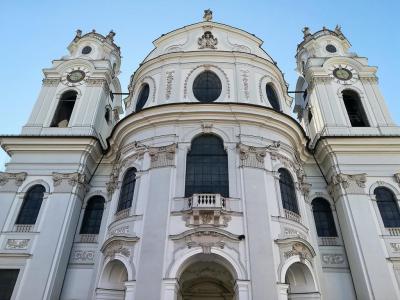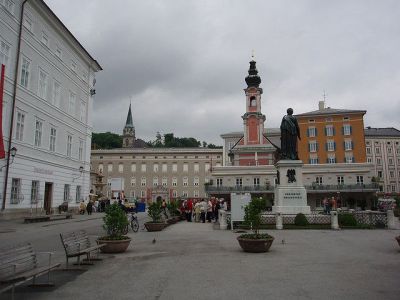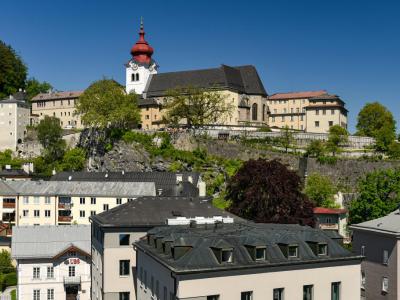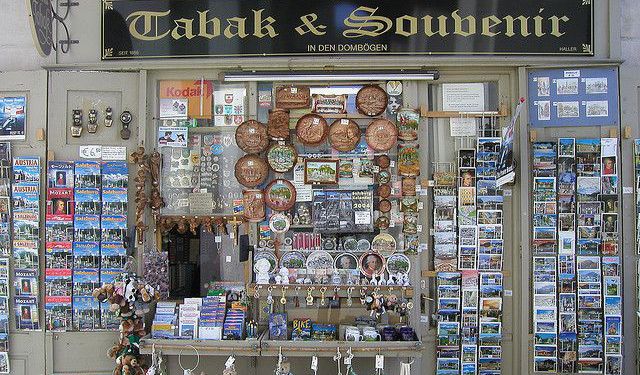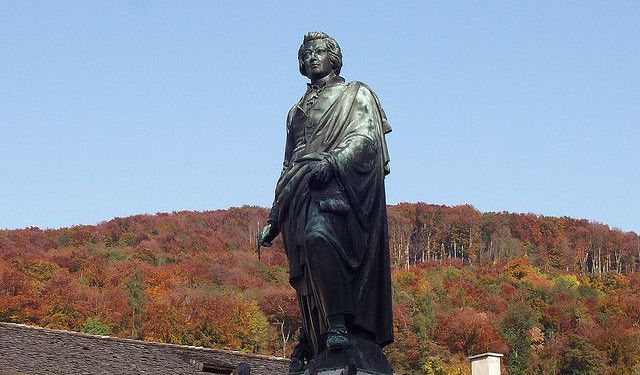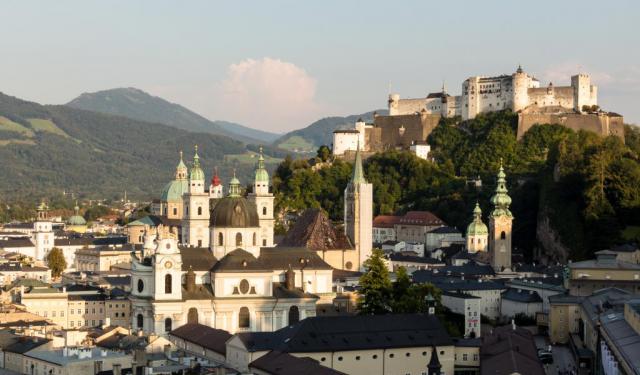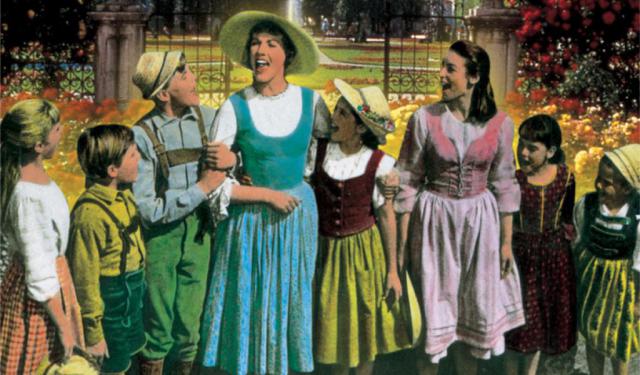Historical Religious Buildings Walking Tour (Self Guided), Salzburg
The historic center of Salzburg, a UNESCO World Heritage Site since 1996, is home to numerous landmarks, including religious sites. Collectively, these historical sanctuaries, from small churches to the impressive Baroque-style Salzburg Cathedral, bear witness to the city's fascinating past and contribute a great deal of charm to its alluring present.
The local Saint Peter's Abbey is one of the oldest monastic settlements in the German-speaking world. Its tranquil graveyard is an attraction in its own right.
The Franciscan Church is another medieval monument in the vicinity. Its Gothic architecture and serene atmosphere make it a true gem, inviting visitors to explore its peaceful interior.
The Collegiate Church boasts a richness of Baroque. Its stunning façade and interior showcase the evolution of Salzburg's religious architecture over the centuries.
Saint Michael's Church, with its bell tower, is a notable feature on Salzburg's skyline. Inside, the church boasts exquisite frescoes and a colorful altar, making it a point of interest for art and history enthusiasts alike.
Finally, the Nonnberg Convent, perched atop a hill, is known for its stunning panoramic views. It is also famous as the real-life convent of Maria von Trapp, inspiring the much loved "The Sound of Music" movie.
To truly appreciate Salzburg's historical churches, take your time to explore their architectural details, immerse yourself in their spiritual ambiance, and soak in the city's rich cultural vibe. Whether you are a devout pilgrim, an art enthusiast, or simply a curious traveler, these sacred sites can offer you a unique window into Salzburg's past and present, sharing their tales with you.
The local Saint Peter's Abbey is one of the oldest monastic settlements in the German-speaking world. Its tranquil graveyard is an attraction in its own right.
The Franciscan Church is another medieval monument in the vicinity. Its Gothic architecture and serene atmosphere make it a true gem, inviting visitors to explore its peaceful interior.
The Collegiate Church boasts a richness of Baroque. Its stunning façade and interior showcase the evolution of Salzburg's religious architecture over the centuries.
Saint Michael's Church, with its bell tower, is a notable feature on Salzburg's skyline. Inside, the church boasts exquisite frescoes and a colorful altar, making it a point of interest for art and history enthusiasts alike.
Finally, the Nonnberg Convent, perched atop a hill, is known for its stunning panoramic views. It is also famous as the real-life convent of Maria von Trapp, inspiring the much loved "The Sound of Music" movie.
To truly appreciate Salzburg's historical churches, take your time to explore their architectural details, immerse yourself in their spiritual ambiance, and soak in the city's rich cultural vibe. Whether you are a devout pilgrim, an art enthusiast, or simply a curious traveler, these sacred sites can offer you a unique window into Salzburg's past and present, sharing their tales with you.
How it works: Download the app "GPSmyCity: Walks in 1K+ Cities" from Apple App Store or Google Play Store to your mobile phone or tablet. The app turns your mobile device into a personal tour guide and its built-in GPS navigation functions guide you from one tour stop to next. The app works offline, so no data plan is needed when traveling abroad.
Historical Religious Buildings Walking Tour Map
Guide Name: Historical Religious Buildings Walking Tour
Guide Location: Austria » Salzburg (See other walking tours in Salzburg)
Guide Type: Self-guided Walking Tour (Sightseeing)
# of Attractions: 6
Tour Duration: 1 Hour(s)
Travel Distance: 1.4 Km or 0.9 Miles
Author: julian
Sight(s) Featured in This Guide:
Guide Location: Austria » Salzburg (See other walking tours in Salzburg)
Guide Type: Self-guided Walking Tour (Sightseeing)
# of Attractions: 6
Tour Duration: 1 Hour(s)
Travel Distance: 1.4 Km or 0.9 Miles
Author: julian
Sight(s) Featured in This Guide:
- Salzburger Dom (Salzburg Cathedral)
- St. Peter's Abbey and Cemetery
- Franziskanerkirche (Franciscan Church)
- Collegiate Church
- St. Michael's Church
- Nonnberg Convent
1) Salzburger Dom (Salzburg Cathedral) (must see)
Absolutely massive, incredibly ornate, and very welcoming towards visitors of all stripes, Salzburg Cathedral (Salzburger Dom) is the 17th-century Baroque church of the Roman Catholic denomination. It is dedicated to Saint Rupert and Saint Vergilius. The former founded the church in 774 on the remnants of a Roman town, and in 1181 the cathedral was rebuilt after a fire. In the 17th century, it was completely remodeled in the Baroque style under Prince-Bishop Wolf Dietrich von Raitenau to its present appearance.
In 1756, Wolfgang Amadeus Mozart was baptized here; the cathedral still contains the 14th-century Gothic baptismal font in which the composer was baptized (just see to the left upon entering). Famously, the grand bronze baptismal font was also used for the baptism of yet another artistic celebrity, Joseph Mohr, the Austrian writer, who wrote the words to the Christmas carol "Silent Night."
During World War II, the cathedral was damaged when a single bomb crashed through its central dome but was completely restored by 1959.
Salzburg Cathedral is framed by three arches linking it to the Residence Palace and Saint Peter's Abbey, creating an enclosed square. The cathedral's façade, made from dark grey stone with bright Untersberg marble, includes three portals leading to bronze doors, surrounded by statues of saints and topped with figures of the four evangelists and a scene of the Transfiguration of Jesus. The cathedral also houses historic bronze gates inside these portals, representing Faith, Hope, and Love, created by renowned sculptors in the mid-20th century.
The oldest bells in the cathedral are the Marien and the Virgil, both cast in 1628. The Salvator bell of the cathedral is the second largest bell in Austria, after the Pummerin bell in Vienna Cathedral.
Once inside, a number of organs are to be admired: one on each side of the high altar and a magnificent one in the rear traditional placing. Make sure to take a minute to sit in a pew and absorb everything around – you won't be disappointed. Cameras are allowed and there are some excellent photo opportunities to be had.
Tip:
Take a downward trip to the crypt – there is as much underground as above.
It is also worth attending a Sunday mass at 10 am, as you get a full orchestra and chorus.
In 1756, Wolfgang Amadeus Mozart was baptized here; the cathedral still contains the 14th-century Gothic baptismal font in which the composer was baptized (just see to the left upon entering). Famously, the grand bronze baptismal font was also used for the baptism of yet another artistic celebrity, Joseph Mohr, the Austrian writer, who wrote the words to the Christmas carol "Silent Night."
During World War II, the cathedral was damaged when a single bomb crashed through its central dome but was completely restored by 1959.
Salzburg Cathedral is framed by three arches linking it to the Residence Palace and Saint Peter's Abbey, creating an enclosed square. The cathedral's façade, made from dark grey stone with bright Untersberg marble, includes three portals leading to bronze doors, surrounded by statues of saints and topped with figures of the four evangelists and a scene of the Transfiguration of Jesus. The cathedral also houses historic bronze gates inside these portals, representing Faith, Hope, and Love, created by renowned sculptors in the mid-20th century.
The oldest bells in the cathedral are the Marien and the Virgil, both cast in 1628. The Salvator bell of the cathedral is the second largest bell in Austria, after the Pummerin bell in Vienna Cathedral.
Once inside, a number of organs are to be admired: one on each side of the high altar and a magnificent one in the rear traditional placing. Make sure to take a minute to sit in a pew and absorb everything around – you won't be disappointed. Cameras are allowed and there are some excellent photo opportunities to be had.
Tip:
Take a downward trip to the crypt – there is as much underground as above.
It is also worth attending a Sunday mass at 10 am, as you get a full orchestra and chorus.
2) St. Peter's Abbey and Cemetery (must see)
Saint Peter's Abbey (Stift Sankt Peter) is a Benedictine monastery and former cathedral. Considered one of the oldest monasteries in the German-speaking world, the abbey was founded in 696 by Saint Rupert. Despite challenges during the Nazi regime in 1938, the abbey maintained operation and remains active to this very day.
A marvelous steeple crowned with an onion dome gives an admirable facade to the Abbey Church. Since its dedication in 1147, this Romanesque church underwent multiple renovations, acquiring its Rococo style in 1782. The church houses significant graves, including that of Martin Luther's superior.
Saint Peter's Abbey is home to Austria's oldest library, comprising nearly 100,000 volumes. The Rococo-style library is particularly noted for its extensive collection of manuscripts, incunabula, and local history volumes, along with special collections of graphics and maps. It also contains a notable collection of music manuscripts from composers like Mozart and Haydn. Additionally, the abbey houses diverse collections of paintings and other artifacts, although some are not accessible to the public. Access to the library requires a special permit.
During his early years in Salzburg, Wolfgang Amadeus Mozart composed the Dominikus Mass for Saint Peter's Abbot Dominikus Hagenauer, in 1769. Hagenauer wrote in his diary: "Music for the Mass composed by Wolfgang Mozart, 14 years of age, was in every one's opinion most elegant. Wolfgang Mozart played on the great organ for half an hour to the astonishment of all." The composer returned to Saint Peter's in 1783 to conduct his "Mass in C minor," which is now performed at the Salzburg Festival each summer.
The abbey complex also contains a very old (established circa 700 AD) cemetery. The oldest graves in Saint Peter's Cemetery (Petersfriedhof) date back to the late 13th century. Distinguished individuals including Mozart's sister Nannerl (an accomplished musician in her own right), Joseph Haydn's brother Michael, and sculptor Josef Thorak are buried here.
The cemetery grounds are also known for the catacombs carved into rocks, which served as early Christian assembly places and hermitages. Wonderful to visit, they are filled with early altars, faded murals, and inscriptions.
In "The Sound of Music" movie, the Von Trapp family goes into hiding from the Nazis at a local cemetery. The actual scene was filmed on a Hollywood set meticulously recreating the setting inspired by Saint Peter's cemetery.
Why You Should Visit:
Everything here is free to visit except for the catacombs which cost a modest fee.
A marvelous steeple crowned with an onion dome gives an admirable facade to the Abbey Church. Since its dedication in 1147, this Romanesque church underwent multiple renovations, acquiring its Rococo style in 1782. The church houses significant graves, including that of Martin Luther's superior.
Saint Peter's Abbey is home to Austria's oldest library, comprising nearly 100,000 volumes. The Rococo-style library is particularly noted for its extensive collection of manuscripts, incunabula, and local history volumes, along with special collections of graphics and maps. It also contains a notable collection of music manuscripts from composers like Mozart and Haydn. Additionally, the abbey houses diverse collections of paintings and other artifacts, although some are not accessible to the public. Access to the library requires a special permit.
During his early years in Salzburg, Wolfgang Amadeus Mozart composed the Dominikus Mass for Saint Peter's Abbot Dominikus Hagenauer, in 1769. Hagenauer wrote in his diary: "Music for the Mass composed by Wolfgang Mozart, 14 years of age, was in every one's opinion most elegant. Wolfgang Mozart played on the great organ for half an hour to the astonishment of all." The composer returned to Saint Peter's in 1783 to conduct his "Mass in C minor," which is now performed at the Salzburg Festival each summer.
The abbey complex also contains a very old (established circa 700 AD) cemetery. The oldest graves in Saint Peter's Cemetery (Petersfriedhof) date back to the late 13th century. Distinguished individuals including Mozart's sister Nannerl (an accomplished musician in her own right), Joseph Haydn's brother Michael, and sculptor Josef Thorak are buried here.
The cemetery grounds are also known for the catacombs carved into rocks, which served as early Christian assembly places and hermitages. Wonderful to visit, they are filled with early altars, faded murals, and inscriptions.
In "The Sound of Music" movie, the Von Trapp family goes into hiding from the Nazis at a local cemetery. The actual scene was filmed on a Hollywood set meticulously recreating the setting inspired by Saint Peter's cemetery.
Why You Should Visit:
Everything here is free to visit except for the catacombs which cost a modest fee.
3) Franziskanerkirche (Franciscan Church) (must see)
The Franciscan Church (Franziskanerkirche) in Salzburg is a historical landmark whose roots extend back to the 8th century AD. Established during Saint Virgil's era, possibly for baptisms, the site was formally documented in 1139 as a parish church. That early structure was destroyed by fire in 1167, but the church was resiliently rebuilt. By 1208, the late Romanesque-style central nave was constructed and consecrated in 1221, marking it one of Salzburg's oldest surviving buildings.
Significant transformations occurred between the 14th and 15th centuries, including a Romanesque choir replaced by the Gothic version in 1450. A Gothic tower, added between 1468 and 1498, further enhanced the church's profile. Initially a parish church dedicated to the Virgin Mary, it was eventually transferred to the Franciscan Order in 1642. An interesting historical note is the shortening of the church's tower, in 1670, because it surpassed the height of the cathedral's tower; the former was restored to its neo-Gothic splendor in 1866.
The 18th century saw a stylistic shift during which the church’s interior was remodeled into a Baroque design. This era introduced the "Rosary" of chapels behind the high altar. The High Altar, crafted in 1709 from red marble and gold, features a central Madonna statue from the late Gothic period, created between 1495 and 1498. Additional artistic elements include a 12th-century marble lion on the pulpit staircase and frescoes on the triumphal arch, enriching the church's historical and artistic legacy.
A grand organ is splendidly placed in an elevated position, and the church is quite enthusiastic about its musical Masses (played each Sunday at 9 am) frequently featuring some of Mozart's compositions. With some luck, you can attend a formal organ concert or listen to the organist practice in the afternoon when you want a quiet place to rest.
Tip:
Make sure you head up towards the altar as the ceilings rise to double the height of the area where the pews are.
Significant transformations occurred between the 14th and 15th centuries, including a Romanesque choir replaced by the Gothic version in 1450. A Gothic tower, added between 1468 and 1498, further enhanced the church's profile. Initially a parish church dedicated to the Virgin Mary, it was eventually transferred to the Franciscan Order in 1642. An interesting historical note is the shortening of the church's tower, in 1670, because it surpassed the height of the cathedral's tower; the former was restored to its neo-Gothic splendor in 1866.
The 18th century saw a stylistic shift during which the church’s interior was remodeled into a Baroque design. This era introduced the "Rosary" of chapels behind the high altar. The High Altar, crafted in 1709 from red marble and gold, features a central Madonna statue from the late Gothic period, created between 1495 and 1498. Additional artistic elements include a 12th-century marble lion on the pulpit staircase and frescoes on the triumphal arch, enriching the church's historical and artistic legacy.
A grand organ is splendidly placed in an elevated position, and the church is quite enthusiastic about its musical Masses (played each Sunday at 9 am) frequently featuring some of Mozart's compositions. With some luck, you can attend a formal organ concert or listen to the organist practice in the afternoon when you want a quiet place to rest.
Tip:
Make sure you head up towards the altar as the ceilings rise to double the height of the area where the pews are.
4) Collegiate Church
The Collegiate Church was built as the place of worship for the adjacent Benedictine University. It is the finest example of Baroque architecture in Salzburg and became the model for other churches in Austria and Southern Germany.
Prince Archbishop Paris London established the Benedictine University in 1623 and made plans to build a church for the university. Renowned architect Johann Bernhard Fischer von Erlach was commissioned to design the building, and the result was one of his finest works. The church was constructed between 1694 and 1707. It was used as a hay store when Napoleon’s army invaded Salzburg and was disbanded in 1810 when the city came under the Bavarian rule. During the Austro-Hungarian rule, it was a secondary school and military church. It was the venue of the Great World Theater in 1922, and in 1964 it regained its original purpose after the University of Salzburg was re-established.
The interior has a modified Greek cross plan with a convex façade. In 1740 a high altar created by Alton Pfaffinger was added with classical columns representing the seven pillars of wisdom. The altar paintings were by celebrated religious artist Johann Michael Rottmayr. The chapels inside are dedicated to the patron saints of the four university disciplines, Saint Thomas Aquinas of theology, Saint Ivo of jurisprudence, Saint Luke of medicine, and Saint Catherine of philosophy.
Prince Archbishop Paris London established the Benedictine University in 1623 and made plans to build a church for the university. Renowned architect Johann Bernhard Fischer von Erlach was commissioned to design the building, and the result was one of his finest works. The church was constructed between 1694 and 1707. It was used as a hay store when Napoleon’s army invaded Salzburg and was disbanded in 1810 when the city came under the Bavarian rule. During the Austro-Hungarian rule, it was a secondary school and military church. It was the venue of the Great World Theater in 1922, and in 1964 it regained its original purpose after the University of Salzburg was re-established.
The interior has a modified Greek cross plan with a convex façade. In 1740 a high altar created by Alton Pfaffinger was added with classical columns representing the seven pillars of wisdom. The altar paintings were by celebrated religious artist Johann Michael Rottmayr. The chapels inside are dedicated to the patron saints of the four university disciplines, Saint Thomas Aquinas of theology, Saint Ivo of jurisprudence, Saint Luke of medicine, and Saint Catherine of philosophy.
5) St. Michael's Church
Saint Michael’s Church is a small pink church located between Residenzplatz and Waggplatz in Salzburg. It is the oldest parish church in the city.
Records show that the Saint Michaels Church existed back in the year 800. At the time, it was the principal place of worship for all sections of society. The Saint Peters monastery maintained the church and it suffered damage and was rebuilt after the fires that ravaged the city in 823 and 1167. It remained the main parish church and palace chapel until 1223 when it was replaced by the Franciscan Church. Although it lost its position as a parish church and its former significance, Saint Michaels church remains a functioning house of worship today.
Saint Michael’s Church has a rococo architectural design. It has two floors. The upper floor was reserved for the emperor and other high officials with easy access from the palace while the lower floor was accessible from the market square for the lower classes. The structure was remodeled between 1767 and 1776 with the addition of a baroque onion dome and an ornamental screen by Philpp Hinterseer. The main altar has a beautiful painting of Saint Michael killing Lucifer and the side altars have paintings of the two archangels, Gabriel and Raphael.
Records show that the Saint Michaels Church existed back in the year 800. At the time, it was the principal place of worship for all sections of society. The Saint Peters monastery maintained the church and it suffered damage and was rebuilt after the fires that ravaged the city in 823 and 1167. It remained the main parish church and palace chapel until 1223 when it was replaced by the Franciscan Church. Although it lost its position as a parish church and its former significance, Saint Michaels church remains a functioning house of worship today.
Saint Michael’s Church has a rococo architectural design. It has two floors. The upper floor was reserved for the emperor and other high officials with easy access from the palace while the lower floor was accessible from the market square for the lower classes. The structure was remodeled between 1767 and 1776 with the addition of a baroque onion dome and an ornamental screen by Philpp Hinterseer. The main altar has a beautiful painting of Saint Michael killing Lucifer and the side altars have paintings of the two archangels, Gabriel and Raphael.
6) Nonnberg Convent
If you’re chasing The Sound of Music dream through Salzburg, chances are you’ll end up at Nonnberg Convent – the real deal behind the singing nuns, runaway governess, and all those "how-do-you-solve-a-problem-like-Maria" moments. Set above the city like a silent guardian since around 712 (yes, that’s not a typo), this Benedictine abbey is officially the oldest of its kind in the entire German-speaking world. It was founded by Saint Erentrudis, niece of Saint Rupert (also known as the “Bishop of Worms”).
The convent’s got all the architectural mood you’d want: Gothic spires, serene cloisters, a pillar hall, a chapel or two (or three), and a kitchen court that, thankfully, doesn’t serve reality TV drama. The ambiance is utterly tranquil – like Gregorian-chant-in-Latin-at-dawn tranquil. Which, incidentally, still happens daily at 6:45 am.
Now, if you're humming Do-Re-Mi already, here's your trivia fix: the real Maria – Maria Augusta Kutschera – checked into this convent to try the nun life at the age of 19 in 1924. She didn’t quite take to it and two years later, left to tutor a sick child of widowed Captain Georg von Trapp. And the rest is musical history. They married in 1927 – she was 22, he was 47, and nobody sang “Age is just a number,” but they might as well have...
Filming fun fact: although The Sound of Music made this place iconic, most of the indoor shots were done in California – apparently nuns don’t like camera crews cluttering up the cloisters. Still, four key scenes were shot just outside the gates: Maria leaving, nuns gossiping musically, the kids visiting, and the Nazi car sabotage moment – an underrated act of holy mischief.
Today, the convent is home to just 14 nuns, down from 50 in the 1960s. But the history still hums through the stone in this serene time capsule...
Pro tip:
Bring a few 50-cent coins. The Convent Museum lets you light up hidden Roman frescoes from 1140 and a baroque altar that’s been standing since 1515. Gothic, Romanesque, and drama-free – just how Saint Erentrudis would've liked it.
The convent’s got all the architectural mood you’d want: Gothic spires, serene cloisters, a pillar hall, a chapel or two (or three), and a kitchen court that, thankfully, doesn’t serve reality TV drama. The ambiance is utterly tranquil – like Gregorian-chant-in-Latin-at-dawn tranquil. Which, incidentally, still happens daily at 6:45 am.
Now, if you're humming Do-Re-Mi already, here's your trivia fix: the real Maria – Maria Augusta Kutschera – checked into this convent to try the nun life at the age of 19 in 1924. She didn’t quite take to it and two years later, left to tutor a sick child of widowed Captain Georg von Trapp. And the rest is musical history. They married in 1927 – she was 22, he was 47, and nobody sang “Age is just a number,” but they might as well have...
Filming fun fact: although The Sound of Music made this place iconic, most of the indoor shots were done in California – apparently nuns don’t like camera crews cluttering up the cloisters. Still, four key scenes were shot just outside the gates: Maria leaving, nuns gossiping musically, the kids visiting, and the Nazi car sabotage moment – an underrated act of holy mischief.
Today, the convent is home to just 14 nuns, down from 50 in the 1960s. But the history still hums through the stone in this serene time capsule...
Pro tip:
Bring a few 50-cent coins. The Convent Museum lets you light up hidden Roman frescoes from 1140 and a baroque altar that’s been standing since 1515. Gothic, Romanesque, and drama-free – just how Saint Erentrudis would've liked it.
Walking Tours in Salzburg, Austria
Create Your Own Walk in Salzburg
Creating your own self-guided walk in Salzburg is easy and fun. Choose the city attractions that you want to see and a walk route map will be created just for you. You can even set your hotel as the start point of the walk.
Old Town Gift Shops
Specialty shops make up an integral part of tourist life in Salzburg. The picturesque Old Town of Salzburg boasts a delightful array of gift shops, all within a pleasant walking distance, offering a diverse range of souvenirs and local treasures. Let's take a stroll through some of the notable establishments in this historic area.
We start at Kirchtag, a quaint gift shop known for its... view more
Tour Duration: 1 Hour(s)
Travel Distance: 0.9 Km or 0.6 Miles
We start at Kirchtag, a quaint gift shop known for its... view more
Tour Duration: 1 Hour(s)
Travel Distance: 0.9 Km or 0.6 Miles
Mozart Walking Tour
Salzburg was Mozart's home throughout most of his short life. For those who wish to immerse themselves in the Mozart world, there are several locations in the city well worth exploring.
Born on Grain Street (Getreidegasse) and baptized in the nearby Cathedral, Mozart played his first big concert, at age 6, at the Residence Palace.
Later, he served as an organist for the Cathedral,... view more
Tour Duration: 2 Hour(s)
Travel Distance: 2.4 Km or 1.5 Miles
Born on Grain Street (Getreidegasse) and baptized in the nearby Cathedral, Mozart played his first big concert, at age 6, at the Residence Palace.
Later, he served as an organist for the Cathedral,... view more
Tour Duration: 2 Hour(s)
Travel Distance: 2.4 Km or 1.5 Miles
Salzburg Introduction Walking Tour
Dubbed the "City of Mozart", the enchanting Austrian city of Salzburg has gone down in history primarily as the hometown of its greatest son, Wolfgang Amadeus Mozart. His birthplace on a busy shopping street called Grain Lane (Getreidegasse) is now a museum. Also popular is the Mozart Residence, a place where the 18th-century composer spent much of his early life.
Apart from Mozart,... view more
Tour Duration: 2 Hour(s)
Travel Distance: 2.8 Km or 1.7 Miles
Apart from Mozart,... view more
Tour Duration: 2 Hour(s)
Travel Distance: 2.8 Km or 1.7 Miles
Sound of Music Tour
Salzburg-home of Mozart, marzipan, and musical nostalgia... While Wolfgang Amadeus gave the city its classical cred, it was The Sound of Music movie that turned Salzburg into a global stage, complete with singing nannies, dancing children, and enough picturesque scenery to make your Instagram weep with joy.
Shot in 1965, this Hollywood juggernaut followed the real-life story of Von Trapp... view more
Tour Duration: 2 Hour(s)
Travel Distance: 4.2 Km or 2.6 Miles
Shot in 1965, this Hollywood juggernaut followed the real-life story of Von Trapp... view more
Tour Duration: 2 Hour(s)
Travel Distance: 4.2 Km or 2.6 Miles
The Most Popular Cities
/ view all
